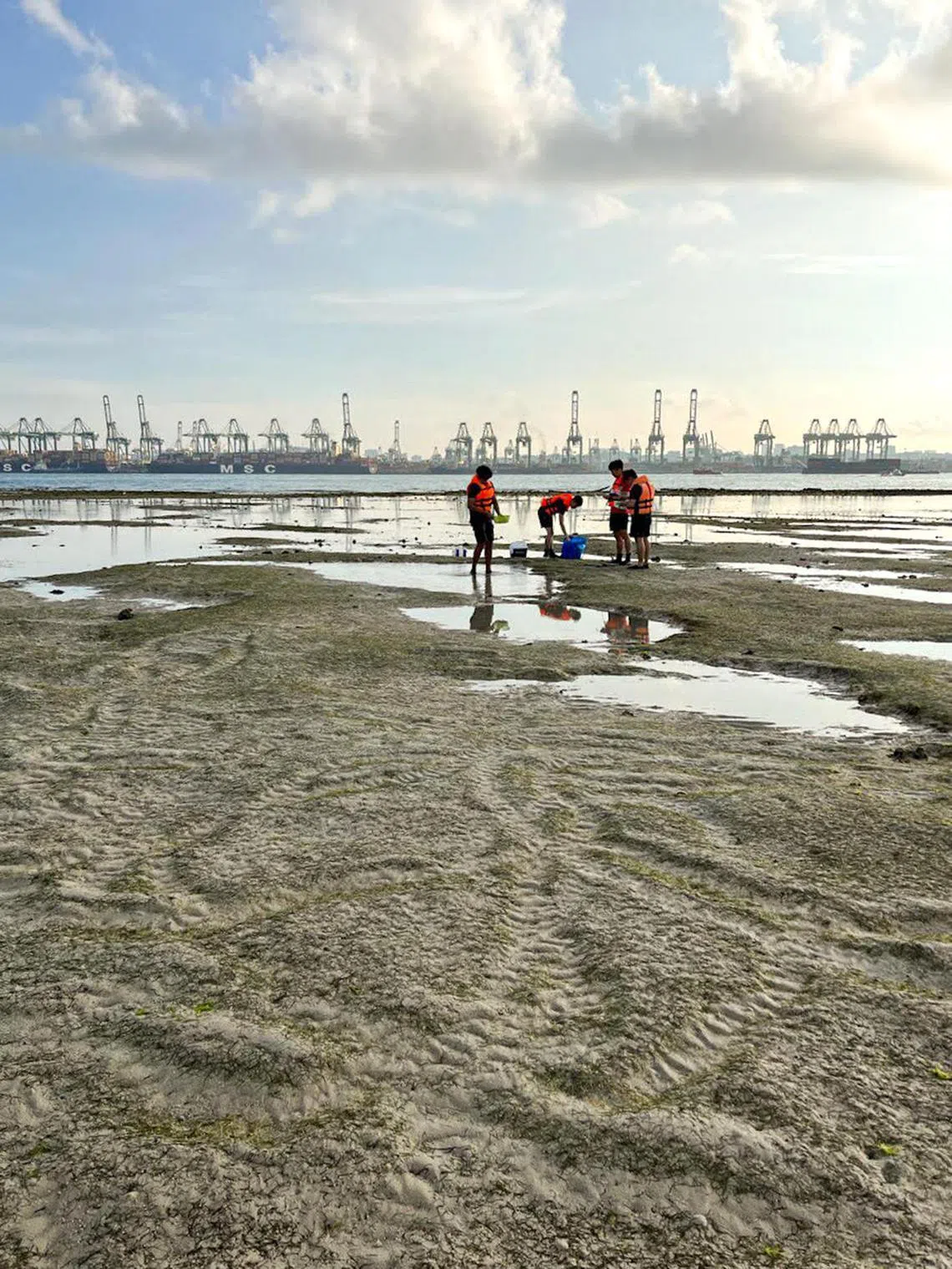See a dolphin, dugong, shark or turtle in S’pore? Tell NUS researchers about it
Sign up now: Get ST's newsletters delivered to your inbox

NUS researchers measuring dugong feeding trails at the seagrass meadows at Cyrene Reefs, near Jurong Island.
PHOTO: COURTESY OF SIRIUS NG
Follow topic:
SINGAPORE – In the depths of the waters surrounding Singapore roam marine creatures such as dugongs, dolphins, sharks, rays and turtles. But spotting them can be tricky, owing to the nation’s murky waters.
Every reported fleeting encounter with these animals can be valuable for marine scientists to glean information such as the animals’ preferred habitats or food types.
Now, marine scientists at NUS want to tap the public to learn more about these elusive marine megafauna, or large marine animals.
On Feb 17, they launched a new public submission database, dubbed MegMaLS (Mega Marine Life in Singapore).
It provides a template for people to submit the location, date and time, as well as any photographs or videos, of such sightings.
The database is an initiative of the NUS department of biological sciences and the university’s Lee Kong Chian Natural History Museum.
Associate Professor Huang Danwei, the museum’s deputy head, said: “This platform is especially critical for faunal (animal) observations and monitoring in our low-visibility waters.”
Singapore’s waters are heavily sedimented because of coastal development in the nation’s early years, resulting in the low visibility.
Prof Huang said the template for submissions will help scientists more easily analyse data, and gain information that can be applied elsewhere, such as for conservation and management.
“It also reduces the time taken for observations to be recorded and analysed, minimising biases that may creep in when observers try to recall details about bygone encounters with marine species,” he added.
Dr Zeehan Jaafar, a senior lecturer at NUS who is also part of the team behind the database, said submissions about wildlife sightings by the public have been critical in helping scientists understand where large marine animals in Singapore, such as dugongs or turtles, can be found.
“However, in the past, we did surveys to request information in an ad hoc way, and for specific species or groups of animals,” she said.
“With this new MegMaLS platform that consolidates sightings of live, injured or dead marine animals, we will be better able to identify any drivers for observed distribution within the territorial waters of Singapore,” Dr Jaafar added.
Mr Sirius Ng, a doctoral student under Dr Jaafar and Prof Huang, has been researching dugongs in Singapore since 2018, in a first-of-its-kind ecological study that is aimed at learning more about the dugong and how it interacts with the local marine environment.
Sightings in Singapore of this marine mammal, which can grow up to 4m long, are incredibly rare.
Mr Ng said dugongs have a greyish brown skin that camouflages well in Singapore’s coastal waters.
Dugongs also do not have dorsal fins – animals with these fins on their backs, such as dolphins and sharks, are more easily spotted when they are in shallow waters.
When dugongs surface to breathe, they do so inconspicuously, often exposing only their nostrils.
Their elusiveness makes it challenging to study them, said Mr Ng.
Conventional survey methods, such as observing the animals from boats, can be costly.
Still, dugongs persist in Singapore’s waters, according to records kept by volunteers.

Dugong feeding trails seen at Chek Jawa on Pulau Ubin.
PHOTO: COURTESY OF SIRIUS NG
Members of Wild Singapore, a naturalist network, have documented over time potential signs of dugong feeding activity in Singapore’s seagrass meadows, said Mr Ng. Such feeding trails look like barren furrows in the seagrass meadows.
“Their records spurred an investigation to confirm if these furrows were indeed made by dugongs,” said Mr Ng.
“We have since verified dugong feeding activity along the seagrass meadows of Changi, Chek Jawa on Pulau Ubin, Pasir Ris, East Coast, at the Cyrene Reef in western Singapore, and Tuas.”

Dugong feeding trails seen at the seagrass meadows of the Cyrene Reef, located near Jurong Island.
PHOTO: COURTESY OF SIRIUS NG
Before such documentation, researchers could rely only on historical records of dugong carcasses that had turned up here over the years.
One of the most recent ones – the carcass of a young dugong – was retrieved off the Cyrene Reef in October 2021. The carcass bore no visible signs of trauma.
Mr Ng said the autopsy results were inconclusive, although observations suggest the possibility of a premature separation between mother and calf.
Overall, Mr Ng’s study has unearthed about 70 records of dugong carcasses, with the oldest dating back to the 1820s.
Mr Ng said he is still looking to answer a few key questions about dugong behaviour in urban environments such as in Singapore, including whether these animals had preferred feeding grounds and times.
Dugongs, which are considered critically endangered here, are vulnerable to human-posed threats while at or near the water surface, where they face high chances of a collision with a vessel. They may also be hunted for food or get ensnared as bycatch in fishing nets.
Habitat losses within their range also pose a threat to dugong populations, said Mr Ng. Dugongs can be found in the Indo-Pacific region, which stretches from the eastern coast of the African continent to the central Pacific Ocean.
“This six-year journey would not have been possible without the significant contributions of citizen scientists to the documentation of Singapore’s marine spaces and wildlife,” Mr Ng added, referring to his study.
“Recognising the value of these contributions to conservation science, we launched MegMaLS to serve as a curated repository for megafauna encounters in our local waters.”
Information obtained through this platform will be useful in informing conservation action, Mr Ng said.
The public submission database for large marine animal sightings, MegMaLS (Mega Marine Life in Singapore), can be accessed at bit.ly/megmals
Audrey Tan is an assistant news editor overseeing sustainability coverage. She has reported on the environment for more than a decade and hosts the Green Pulse podcast series.


